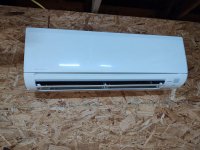Crazyraceguy
Member
- Joined
- Oct 16, 2015
- Messages
- 5,505
I have been slowly messing around with turning the garage into a woodworking shop. By slowly, I mean about 80% of the walls are furred out and insulated, ceiling is next.
The big thing is the mini-split, 12k BTU Mitsubishi, installed today. It was a fairly nice day for working outside. It rained like crazy yesterday and was in the upper 90s every day last week, never over 83 today.
It took them about 4 hours, with training a helper. I was very impressed with how quiet that thing was.
Even with my incomplete insulation, it seems to take the heat away very quickly.
Things might move along a little faster now that it will be bearable out there.
The big thing is the mini-split, 12k BTU Mitsubishi, installed today. It was a fairly nice day for working outside. It rained like crazy yesterday and was in the upper 90s every day last week, never over 83 today.
It took them about 4 hours, with training a helper. I was very impressed with how quiet that thing was.
Even with my incomplete insulation, it seems to take the heat away very quickly.
Things might move along a little faster now that it will be bearable out there.

